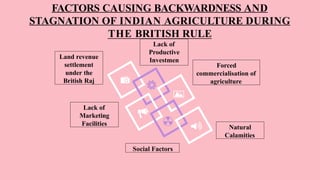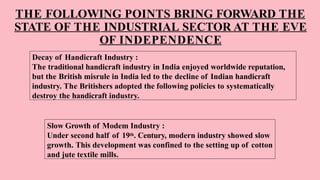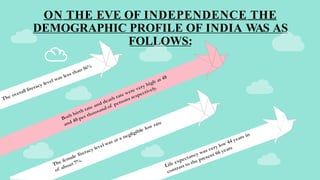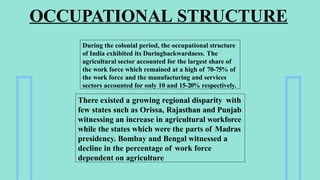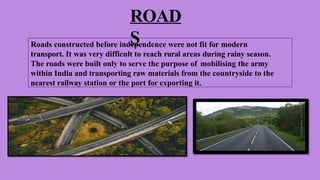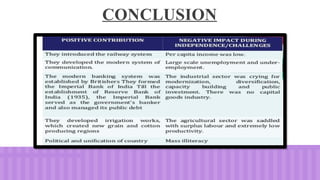Indian Economy on Eve of independence Detailed notes.pptx
- 1. INDIAN ECONOMY AT THE EVE OF INDEPENDENCE
- 2. OBJECTIVE To become familiar with the state of the Indian economy in 1947, the year in which India got independence. Understand the factors that led to the underdevelopment and stagnation of the Indian economy.
- 3. TOPICS TO BE COVERED •Low level of economic development under the colonial rule •Agriculture sector •Industrial sector •Foreign trade •Demographic condition •Occupational structure •Infrastructure
- 4. Introduction The primary objectives of British colonial rule in India was to turn India : • As a supplier of raw materials. • As a consumer of finished goods.
- 5. Colonialism Colonialism is the policy of a country seeking to extend or retain its authority over other people or territories, generally with the aim of economic dominance.In the process of colonisation, colonisers may impose their religion, language, economics, and other cultural practices on indigenous peoples. In case of India, the unequal relationship between the colony [India] and the ruling country [Britain] resulted in underbelly of India.
- 6. LOW LEVEL OF ECONOMIC DEVELOPMENT UNDER THE COLONIAL RULE Before the arrival of British in India, our country has an independent economy. Agriculture was there main source of livelihood for most of the people. Along with agriculture there were other people who performed manufacturing activities. The handicraft industry of out country was well known as over the world. The products were well known for their fine quality for the material and the high standard of craftsmanship. ‘DACCAI MUSLIN’ , a type of cotton textile found in Dhaka was famous all over the world
- 7. LOW LEVEL OF ECONOMIC DEVELOPMENT DURING THE COLONIAL RULE In India the colonial government adopted the policies only to promote their interests. There policies were adopted only to vendor the economic interest of their home country. They totally neglected the development of the Indian economy. Such polices by the colonial government changed the structure of the Indian economy. India was transformed into a supplier of raw material and costumer of final good from Britain
- 8. ESTIMATION OF NATIONAL INCOME DURING THE COLONIAL GOVERNMENT RULE The colonial government never tried to estimate India’s national and per- capita income. Some individuals attempted to measure but their results were conflicting and inconsistent. Some of them were : • Dada Bhai naroji • William digby • Findly Shiras • V.K.R.V Rao • R.C desai
- 9. The estimate given by V.K.R.V Rao during colonial period was considered very important. Most studies price that the country’s growth of aggregate real output was less than 2% during first half of 20th century. The growth in port capita output per year was nearly half percent.
- 10. Agriculture sector Agricultural Sector on the Eve of Independence India’s agricultural sector (on the eve of independence) exhibited three principal characteristics, these characteristics pointed to backwardness of India’s agriculture as well as its stagnation •Low level of productivity •High degree of vulnerability •A wedge between owners of the soil and tillers of the soil.
- 11. FACTORS CAUSING BACKWARDNESS AND STAGNATION OF INDIAN AGRICULTURE DURING THE BRITISH RULE Land revenue settlement under the British Raj Forced commercialisation of agriculture Lack of Marketing Facilities Lack of Productive Investmen Social Factors Natural Calamities
- 12. INDUSTRIAL SECTOR In the pre-british period, India was particularly well-known for its handicraft industries, in the fields of cotton and silk textiles, metal and precious stone works, etc. These products enjoyed a worldwide market based on the reputation of the fine quality of material used and the high standards of craftsmanship. But the Britishers followed a policy of systematic de-industrialisation by creating circumstances conducive to the decay of handicraft industry and not taking any steps to promote modern industry and reduced India to a mere exporter of raw material and importer of finished goods.
- 13. THE FOLLOWING POINTS BRING FORWARD THE STATE OF THE INDUSTRIAL SECTOR AT THE EVE OF INDEPENDENCE Decay of Handicraft Industry : The traditional handicraft industry in India enjoyed worldwide reputation, but the British misrule in India led to the decline of Indian handicraft industry. The Britishers adopted the following policies to systematically destroy the handicraft industry. Slow Growth of Modem Industry : Under second half of 19th. Century, modern industry showed slow growth. This development was confined to the setting up of cotton and jute textile mills.
- 15. FOREIGN TRADE India has been an important trading nation since ancient times. But when the restrictive policies of commodity production, trade and tariff were imposed by the colonial government, it adversely affected the structure, composition and volume of India’s foreign trade.
- 17. FOLLOWING WERE THE REASONS BEHIND THE POOR GROWTH OF FOREIGN : Exporter of Primary Products and Importer of Finished Goods Under the colonial rule, India became an exporter of primary products such as raw silk, cotton, wool, sugar, indigo, jute, etc and an importer of finished consumer goods like cotton, silk and woollen clothes and capital goods like light machinery produced in the factories of Britain. Britain’s Monopoly Control Britain maintained a monopoly control over India’s exports and imports. Due to this, more than half of India’s foreign trade was restricted to Britain while the rest was allowed with a few other countries like; China, Ceylon (Sri Lanka) and Persia (Iran). The opening of Suez Canal in 1869 further intensified British control over India’s foreign trade.
- 18. DRAIN OF INDIAN WEALTH
- 19. EXPORT SURPLUS WAS USED FOR : An important characteristic of foreign trade throughout the colonial period was the generation of a large export surplus. But this surplus came at a huge cost to the country’s econo Several essential commodities like food grains, kerosene, were scarcely available in the domestic market. Also, this surplus was not used in any developmental activity of India. Rather, it was used to maintain the administrative set-up of the Britishers or bear the expenses of war taught by Britain. All of this, led to the drain of Indian Under the British rule, India became an exporter of raw materials and an importer of finished goods. There was a huge export surplus due to excess exports. To make payments for administrative expenses incurred by the British government in Britain To meet expenses on the war fought by the British Government.
- 21. DEMOGRAPHIC PROFILE Various details about the population of British India were first collected through a census in 1881. Before 1921, India was in the first stage of demographic transition. The second stage began after 1921. However neither the total population of India nor the rate of population growth at this stage was very high. Though suffering from certain limitations, it revealed the Unevenness in India’s population growth. The population grew at a rate of 1.2% up to the year 1951.
- 22. ON THE EVE OF INDEPENDENCE THE DEMOGRAPHIC PROFILE OF INDIA WAS AS FOLLOWS:
- 23. OCCUPATIONAL STRUCTURE During the colonial period, the occupational structure of India exhibited its Duringbackwardness. The agricultural sector accounted for the largest share of the work force which remained at a high of 70-75% of the work force and the manufacturing and services sectors accounted for only 10 and 15-20% respectively. There existed a growing regional disparity with few states such as Orissa, Rajasthan and Punjab witnessing an increase in agricultural workforce while the states which were the parts of Madras presidency. Bombay and Bengal witnessed a decline in the percentage of work force dependent on agriculture
- 25. INFRASTRUCTURE Infrastructure comprises of such industries which help in the growth of other industries. Under the colonial period, basic infrastructure such as railways, port per transport, posts and telegraphs developed. However, the real motive behind this development was not to provide basic amenities to the people but to sub serve various colonial interests.
- 26. ROAD S Roads constructed before independence were not fit for modern transport. It was very difficult to reach rural areas during rainy season. The roads were built only to serve the purpose of mobilising the army within India and transporting raw materials from the countryside to the nearest railway station or the port for exporting it.
- 27. RAILWAYS British rulers introduced railways in India in 1850 and it began its operation in 1853. It is considered as one of the important contribution of Britishers. The railways affected the structure of the Indian economy in the following two ways It enabled people to undertake long distance travel and thereby break geographical and cultural barriers. It fostered commercialisation of Indian agriculture which adversely affected the self-sufficiency of the village economies in India. So, the social .benefits provided by the Railways was outweighed by the country’s huge economic loss.
- 28. WATER AND AIR TRANSPORT Water and Air Transport The colonial rulers took measures for the development of water transport. The inland waterways, at times, also proved uneconomical as in the case of the coast canal on the Orissa coast. The main purpose behind their development was to serve Britain’s colonial interest. The colonial government also showed way to the air transport in 1932 by establishing Tata Airlines. Thus, in this way it inaugurated the aviation sector in India.
- 29. COMMUNICATION Modern postal system started in India in 1837. The first telegraphy line was opened in 1857. The introduction of the expensive system of electric telegraph in India served the purpose of maintaining law and order.
- 30. CONCLUSION
- 31. THANK YOU



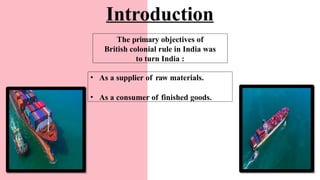
![Colonialism
Colonialism is the policy of a country seeking to extend or retain its authority over other
people or territories, generally with the aim of economic dominance.In the process of
colonisation, colonisers may impose their religion, language, economics, and other cultural
practices on indigenous peoples.
In case of India, the unequal relationship between the colony [India] and the
ruling country [Britain] resulted in underbelly of India.](https://image.slidesharecdn.com/indianeconomyonevedetailednotes-250521132649-cbb8cd42/85/Indian-Economy-on-Eve-of-independence-Detailed-notes-pptx-5-320.jpg)





